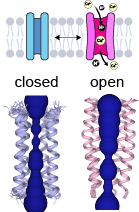Coronavirus envelope protein
L]]
Coronavirus envelope protein (E protein) is a crucial structural protein found in coronaviruses, a large family of viruses that cause illnesses ranging from the common cold to more severe diseases such as Middle East Respiratory Syndrome (MERS) and Severe Acute Respiratory Syndrome (SARS). The E protein plays a significant role in the virus's lifecycle, including assembly, budding, envelope formation, and pathogenesis.
Structure and Function[edit | edit source]
The coronavirus envelope protein is a small, integral membrane protein that is typically about 8-12 kDa in size. It consists of a short hydrophilic amino terminus, a hydrophobic domain that spans the membrane, and a hydrophilic carboxyl terminus that is located inside the virion. This structure allows the E protein to perform various functions within the virus lifecycle.
One of the key roles of the E protein is in the assembly and release of the virus. It is involved in the budding process, where new virions exit the host cell. The E protein interacts with other structural proteins of the virus, such as the M protein, to promote virion assembly and release.
Additionally, the E protein is involved in the formation of the virus's envelope. This lipid bilayer is critical for the virus's ability to infect host cells. The E protein can form ion channels, which are thought to play a role in virus pathogenesis by altering the host cell's internal environment.
Pathogenesis[edit | edit source]
The coronavirus envelope protein is also implicated in the pathogenesis of the virus. Its ion channel activity can disrupt the ionic balance within host cells, leading to cell stress or death. This activity may contribute to the symptoms observed in coronavirus infections.
Moreover, the E protein has been shown to interact with host cell processes and immune responses. It can modulate the host's immune system, aiding the virus in evading immune detection and contributing to the severity of the disease.
Research and Therapeutic Implications[edit | edit source]
Given its critical role in the coronavirus lifecycle and pathogenesis, the E protein is a target for research aimed at understanding the virus and developing treatments. Inhibitors that block the ion channel activity of the E protein or interfere with its other functions could potentially serve as antiviral therapies.
Research into the coronavirus envelope protein also enhances our understanding of virus-host interactions and the mechanisms by which viruses cause disease. This knowledge is crucial for the development of vaccines and therapeutic strategies against coronaviruses and other viral pathogens.
Conclusion[edit | edit source]
The coronavirus envelope protein is a vital component of the coronavirus, contributing to its structure, replication, and pathogenesis. Understanding the E protein's functions and interactions with the host cell offers insights into the virus's lifecycle and potential therapeutic targets for combating coronavirus infections.
Navigation: Wellness - Encyclopedia - Health topics - Disease Index - Drugs - World Directory - Gray's Anatomy - Keto diet - Recipes
Search WikiMD
Ad.Tired of being Overweight? Try W8MD's physician weight loss program.
Semaglutide (Ozempic / Wegovy and Tirzepatide (Mounjaro / Zepbound) available.
Advertise on WikiMD
WikiMD is not a substitute for professional medical advice. See full disclaimer.
Credits:Most images are courtesy of Wikimedia commons, and templates Wikipedia, licensed under CC BY SA or similar.Contributors: Prab R. Tumpati, MD






